Allison Arwady is so relaxed and cheerful when she welcomes me into her office in the Loop headquarters of the Chicago Department of Public Health that I start our conversation by saying, “I think you may be the least depressed person in Chicago right now.” To be fair, the bar is low. It’s the week after Thanksgiving, the summer’s lull in COVID-19 infection rates is well behind us, and the city is once again closing down as the virus begins its long-predicted winter surge.
Arwady responds to my remark with a full-throated laugh that is loud enough to turn the head of a staffer walking down the hall. I’d eventually learn that Arwady is famous for that laugh, which more than one colleague of hers would refer to (pun intended or not) as infectious.
Earlier, Arwady told me her mood tends to rise and fall with the daily positivity rate, and I know that the numbers have been slightly better the past couple of days, so maybe that explains it. Also, making oneself useful is a time-tested antidote to despair, and it’s hard to imagine a more useful person in the city right now than Chicago’s commissioner of public health.
After a few minutes of small talk, Arwady and I gather our belongings and walk toward the elevator, her two assistants in tow. The commissioner has invited me to accompany her five blocks north to City Hall, where she’ll be conducting this week’s installment of “The Doc Is In: Ask Dr. Arwady,” a live Q&A on social media that has, together with her regular press briefings alongside Mayor Lori Lightfoot and Governor J.B. Pritzker, made her a familiar face to Chicagoans over the past nine months.
Outside, a black SUV is waiting. Arwady climbs in front while the two assistants and I pile in the back, cracking the windows despite the sleeting weather.
“Oh, look!” Arwady says, turning to the driver. “Tony’s taking us today. Good. These things tend to go better when Tony drives us.”
“Why is that?” I ask.
I can’t quite make out Tony’s response, which is muffled by his mask, but whatever he says, it makes Arwady laugh again.
One of the assistants says, “I think it’s because he has the joy of life. Is that it, Tony?”
The mood inside the SUV is unexpectedly boisterous, making it feel more like I’m shadowing an actor on her way to opening night than accompanying a public official about to brief frightened citizens on a deadly pandemic. Maybe it’s simply that I haven’t been in a car with anyone outside my household in nine months, but I feel my spirits lifting. Or maybe, like so many suffering from COVID fatigue, I’ve simply forgotten how good it feels just to be going to a place to do a thing.
It’s a quick ride, the weekday congestion of the Loop having long ago thinned to a few police cruisers and a smattering of pedestrians. At City Hall, the usual throng in front of security is nowhere to be seen. We pass single file through the metal detectors, and I’m the only one who’s startled when a computerized voice announces, “You do not have a fever.”
As we wait for the elevator, Arwady turns to exchange pleasantries with a short, masked woman in a long coat, adopting the same chummy tone she used with Tony. It’s only when I look up from my notepad as we’re boarding the elevator that I realize the woman Arwady was talking to was the mayor.
Upstairs, the press room seems cavernous without any reporters to fill it. I find a seat near the window while Arwady preps with her staff and then, just before starting, steps toward the window to apply a bit of powder and lipstick, as an afterthought. She takes a seat six feet away from Sybil Madison, the city’s deputy mayor of education and human services, and they go live.
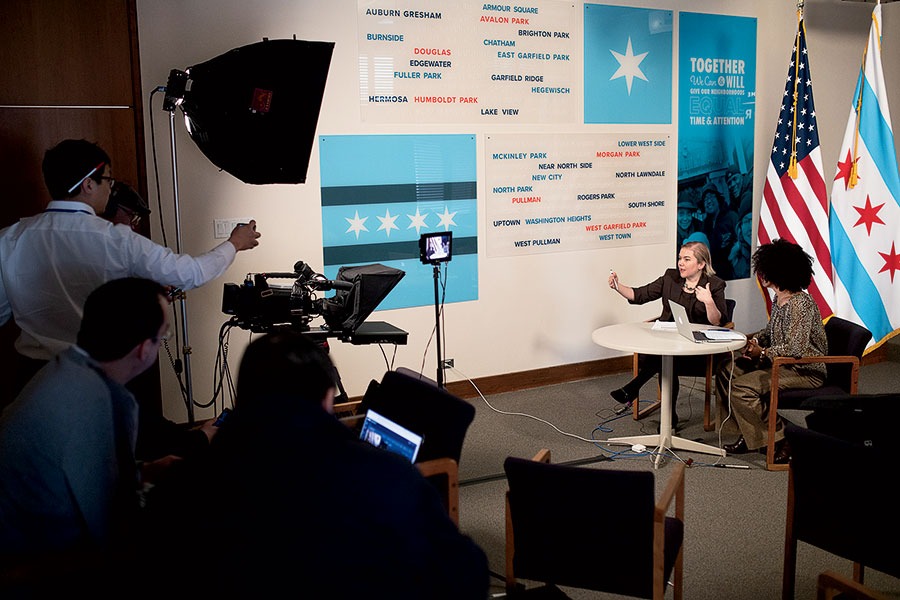
She opens with the COVID numbers. “The current positivity rate across the city is at 11.6 percent. Now that’s down from 12.2 percent a week ago. If we look at our daily case average, we see that it’s at 1,324 new cases per day. That’s still much higher than we want it to be. … If you are somebody who gathered or who traveled for Thanksgiving, remember that really we consider that to have been a fairly high-risk exposure, just given how much COVID is in the country and even here in Chicago at the time, so a reminder that for now 10 days — and we’ll probably talk about the CDC guidance here — minimum of really 10 days after that, and ideally up to 14 days, you should be being extra careful.”
I’m struck by the nonjudgmental manner in which she relays this advice. Whereas other government officials — the governor of New York, for example — have resorted to shaming their constituents for their lack of caution, Arwady doesn’t seem to find much use in castigation. She is, after all, a physician, and evidently knows the importance of a comforting bedside manner.
She concludes her opening remarks on a sobering note: “We still have 1,100 people in Chicago hospitals today not in the ICU, another almost 300 in the ICU. We’re still estimating between one in 19 and one in 27 Chicagoans is infectious with COVID. … So our work is not done. Some good progress this week.” Then they turn to questions.
The first one, not surprisingly, is about the vaccine. A resident wants to know if it’s true that she’ll need to quarantine for two weeks after getting immunized.
“That’s a good question,” Arwady says, and then, using the straightforward language of an AP biology teacher, proceeds to explain why mRNA vaccines do not expose recipients to the actual virus. What most impresses me about her answer, though, are those first four words: That’s a good question. Asking if a vaccine risks giving you a full-blown case of the contagious disease you’re being vaccinated against seemed to me the opposite of a good question, and yet Arwady has long understood what so many of us miss: Effective communication hinges more on listening than on speaking. “Everybody wants to feel heard,” Arwady tells me later. “Nobody wants to be shut down or ignored. In any outbreak, communication is the major thing that you gotta get right. At the beginning of this, there was so much misinformation and confusion. I really wanted the opportunity to take direct questions. We had never done anything like this, but people were afraid.”
Arwady admits that she was nervous about a live Q&A at first. It was a lot of unscripted time, all of it on the record. But she decided it was worth the risk. For one thing, it would give her a chance to hear what kinds of rumors and half-truths were circulating along with the virus. Over the course of the year, she’s come to recognize regular viewers, especially those one might call trolls. “There are people who want to share some conspiracy theory about the virus: ‘Isn’t it true that COVID’s no worse than the flu?’ ‘Aren’t doctors overstating the risk so they can make more money?’ ‘Isn’t there some risk the vaccines will give you COVID?’ ” Arwady says she takes those questions seriously. “I’ll use it as a chance to say, ‘Well, actually, if we look back at all the data, you can see here that more people have already died of COVID this year alone than of the flu in the past five.’ So I try to counteract the misinformation with facts. And the truth is, even when questions are based on misinformation, they can be interesting. People think the things they think for a reason, and when they believe things that aren’t true, it tells you what’s in the air.”
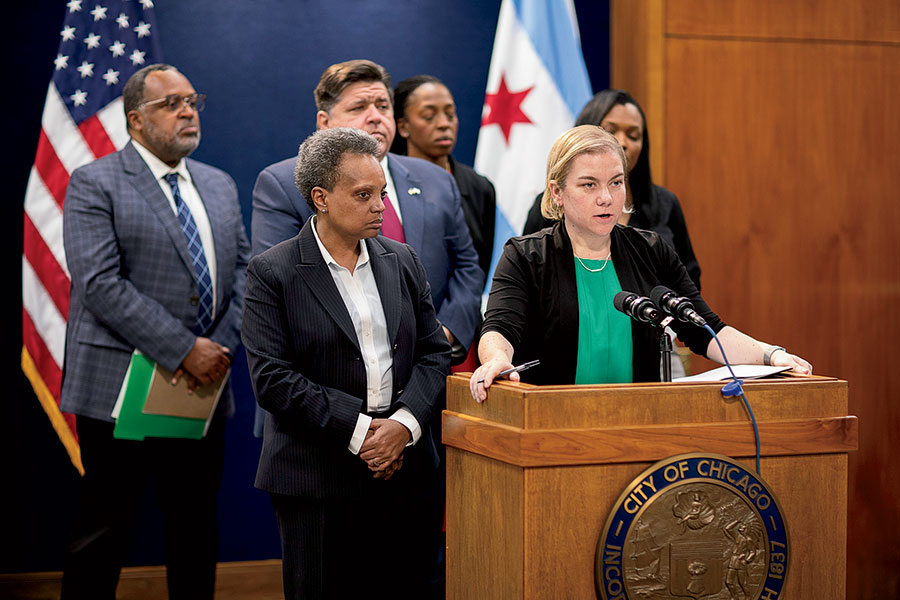
Commissioner of the Chicago Department of Public Health is not exactly the sexiest title. When we think of heroic figures who keep a city running, we might picture a headstrong mayor, a fearless fire chief, a relentless state’s attorney. Public health commissioners are more likely to be associated with restaurant inspections than courage under fire — at least when things are going well.
It’s a common adage that if you don’t have your health, you don’t have anything. You could argue that this is the case for a city as much as for an individual. Most of us take for granted the structures and systems that allow us to drink clean water, to be safe from deadly microbes in public spaces, to go to a doctor when we are sick, and to perform so many of the other activities that allow city dwellers to live decent lives — that is, until those systems are disrupted. Only then do we begin to appreciate not only the person who runs into a burning building to save those trapped inside, but also the person who has put a plan in place to keep the fire from burning down the whole damn block.
As I tried to understand how the 44-year-old Arwady became that person, my mind circled back to an anecdote she’d related to me about a medical school sabbatical she’d taken in 2006 to study tuberculosis in Botswana. I remembered her speaking about the deadly lung disease, about its pathologies and mutations, the way one might reminisce about an old friend. It wouldn’t be a stretch to say that mass contagion has been an obsession for Arwady at least since she was an undergraduate, when she first read Charles E. Rosenberg’s The Cholera Years, which chronicles outbreaks of the disease during the 19th century. In fact, when I asked Arwady during our first interview if she was suffering from COVID fatigue like everyone else, she answered that she guessed she was probably immune: “Even if I weren’t health commissioner, I’d probably be reading about this all the time, studying it, talking to people about it constantly.”
As much history buff as epidemiologist, Arwady — a native of Kalamazoo, Michigan, who has a bachelor’s from Harvard, a master’s from Columbia, and a medical degree from Yale — has long been interested in the social and cultural implications of infectious disease. Consider cholera, she says: “It tended to affect people who were poorer, and so people began to look at it as a problem of cleanliness or morality.” As a medical student, she studied how the spread of HIV and tuberculosis was influenced by migration between the United States and Mexico: People who were HIV positive were bringing the disease into Mexico while TB tended to move north, each disease carrying its own particular stigma. In studying this history, Arwady began to understand outbreaks in a way few medical professionals do: “I realized that the way we think about disease and health is a little biological, but it’s also about our moral beliefs, our religious beliefs, our national priorities. We imagine disease to always show up in the same way in individuals because it’s biological, but this couldn’t be further from the truth.”
Her research in Botswana, part of a Centers for Disease Control and Prevention fellowship, focused on the challenge of diagnosing tuberculosis in a country where X-ray machines were in extremely short supply. She traveled to different clinics around the country and observed doctors who had to keep track of active and suspected TB cases in paper ledgers. Witnessing the life-and-death consequences of this lack of basic resources starkly exposed a critical distinction for Arwady: the chasm between making public health policies and implementing them.
Botswana would prove a useful prelude to Arwady’s eventual return to the CDC. In 2013, after completing her medical residency, she enrolled in the agency’s Epidemic Intelligence Service, an elite group of doctors and postdoctoral students specially trained to investigate infectious disease crises domestically and abroad. Jennifer Hunter, a friend of Arwady’s and a fellow graduate of the program, describes EIS officers as “disease detectives” and says Arwady immediately made an impression on her: “Allison had this incredible memory for the places she’s been and the people she’s met, the history, and the culture, and the architecture. She stood out in that way. A lot of people who go into EIS are often very accomplished, but she was different.”
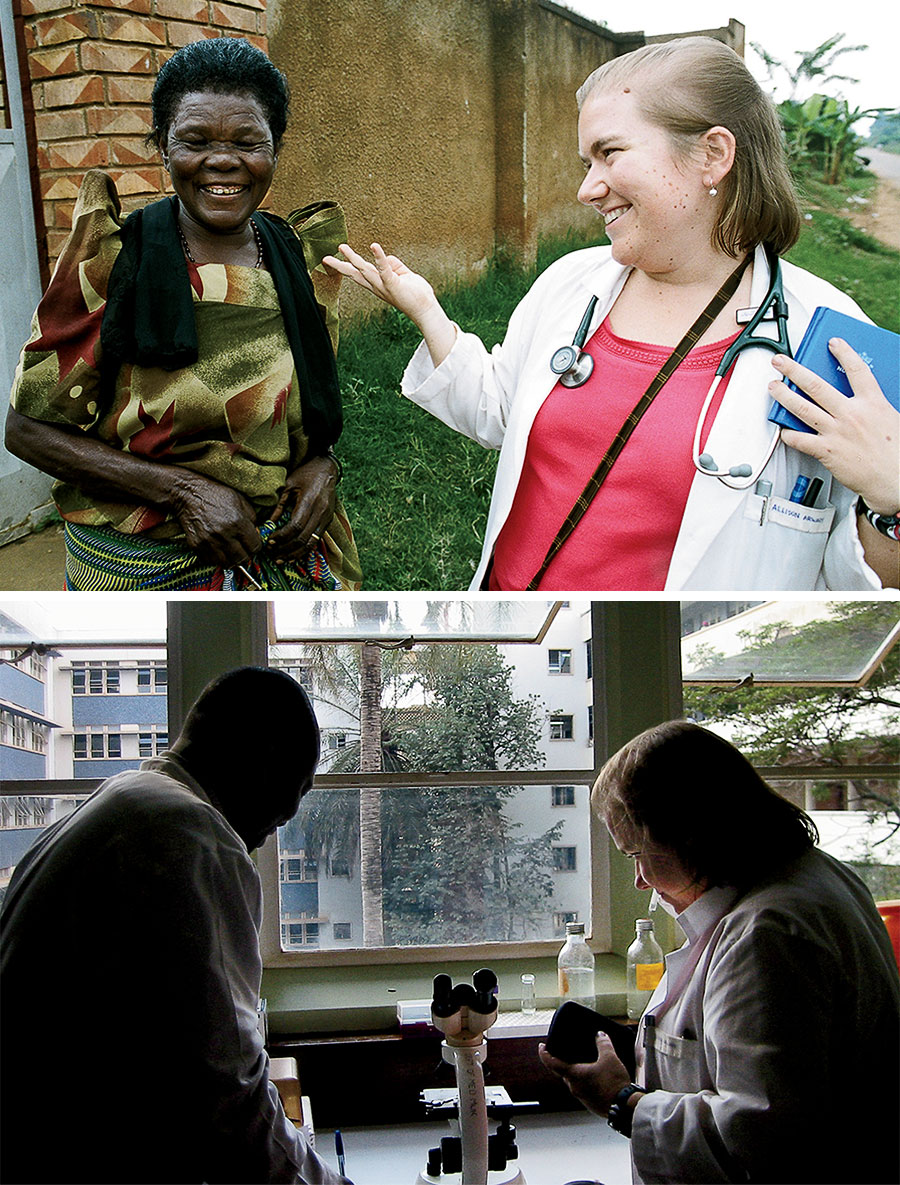
In 2014, Arwady and a few dozen other EIS doctors were deployed to Liberia, which was in the grip of a devastating Ebola outbreak. A viral disease, Ebola is spread through contact with even trace amounts of bodily fluid. Two days to three weeks after infection, people experience fever, sore throat, and muscle pain, followed by vomiting, diarrhea, rash, decreased function of the liver and kidneys, and, finally, internal and external bleeding. Roughly half of those who contract the disease die, and because of the ease of transmission, health care workers treating infected patients put themselves at immense risk.
What disturbed Arwady the most during that first deployment (she returned for a second one in 2016) was not so much the gruesome symptoms of the disease itself but the calamitous lack of resources to combat it. Liberia’s entire health care system had virtually collapsed, causing a cascade of misery that Arwady describes as “tragedy compounded by tragedy.” As she puts it, “Everybody knew what needed to be done, and nobody had what they needed to do it.” She remembers arranging a meeting in Monrovia, the capital, with the man in charge of dispatching ambulances in the city, in hopes of persuading him to send out more. “Not only did he not have any more ambulances,” she says, “he didn’t even have paper to write on. The phone lines were down. Communication was impossible.”
Not long after that encounter, she arrived at a hospital that had been abandoned except for a group of infected staff members. Arwady recalls being in a building nearby trying to figure out how she and her colleagues, who had run out of personal protective equipment, could get food into the hospital without getting infected themselves. “I remember sitting in this room. There was no electricity. And this man came in and begged me to help his wife, a nurse who was inside the hospital. ‘My wife is in there,’ he kept saying. ‘My wife is in there and she’s sick. What are you doing to get her out?’ ” She tried to reassure him, but there was little she could do. At another hospital, the staffers were so short on PPE that they would leave a single pair of gloves next to each Ebola patient so that they could be reused. “The health care workers would come in and try to put this same pair of gloves on. This is a disease where if you have a tiny cut on your hand and you touch that glove, you will get Ebola.”
Arwady also observed with horror the ripple effects of a health care system broken by a single disease. “Everyone stopped being able to get care,” she says. “There was nowhere to go if you got in a car accident or if you were having a baby or you needed your HIV meds.” She realized that more people could end up dying from those other things than from Ebola itself.
When Arwady was officially named public health commissioner in January 2020 (she’d been serving in an acting capacity for seven months), her experiences in EIS motivated her to focus heavily on emergency preparedness. Just a year before, as the city’s chief medical officer, she’d helped oversee Crimson Contagion. The simulation, which involved 19 federal agencies and 87 hospitals, examined how the country would manage an outbreak of a hypothetical novel strain of influenza. The results of the drill foreshadowed many of the problems that COVID would soon lay bare: medical-supply-chain breakdowns, shortages of PPE, conflicts surrounding the Defense Production Act. Arwady came away from the exercise determined to improve the city’s readiness, but nothing could have prepared her for the sheer scope of what was to come.
“Chicago was in far better shape than a lot of places when COVID hit,” she says. “We had millions of N95s on hand, millions of gloves. But nevertheless, it was scary the way the supply chains were disrupted. It was a completely bizarre and almost surreal experience for me during those first months of COVID to be sitting in America, in the wealthiest country in the world, in an extremely well-resourced system in Chicago, a system in better shape than a lot of places, and still feeling like I had to worry about having enough ventilators or enough PPE.”
A lesson she’d learned in Africa suddenly took on urgent relevance at home — namely, that no amount of medical knowledge in the world will save people if there is a lack of basic resources, if there aren’t stockpiles in place, if there isn’t a plan.
More than once I asked Arwady how she dealt with the existential fear that gripped the city as the pandemic bore down. Did she give in to moments of panic herself? Her response was laconic. “I do think that when things get crazy, I go calm,” she told me. “Maybe it’s just my temperament.” Overall, Arwady, who has no spouse or children, was circumspect on any subject that veered toward the personal, though she did allow that books are a refuge — Abraham Verghese’s Cutting for Stone, a novel about twin brothers working as doctors in Ethiopia, is a recent favorite. In November, she made the news when she and her colleagues in the health department released a public service video of them reading a poem Arwady had written. It began: “We don’t care about your politics / Don’t care about your views / Don’t care about the channel where you watch your evening news / Doesn’t matter how you voted / We don’t care to whom you give / The only thing we care about is: Do you want to live?”
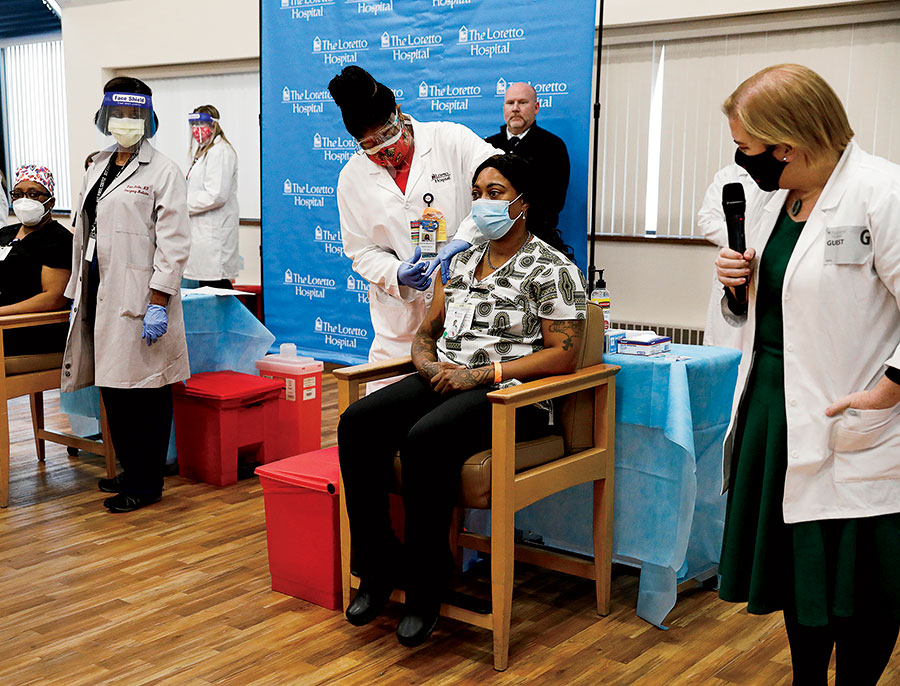
Arwady is what you might call a systems person. She believes that public health officials must do everything they can to protect not just the patients but the systems that keep health care going. She has also learned that patients and the systems that sustain them are interconnected in delicate ways that often don’t become apparent until a crisis comes along.
Tina Anderson, the deputy commissioner for COVID-19 response at the Chicago Department of Public Health, recalls a conversation she had with Arwady last spring. Anderson couldn’t wrap her head around the idea that the city was not able to get enough COVID tests to track the spread. It was a simple test, not complicated to manufacture. “Allison explained to me that the problem wasn’t one of microbiology but of systems.” The reason Chicago didn’t have enough tests, she told Anderson, was that there weren’t enough swabs. The reason there weren’t enough swabs was that the swabs were manufactured in Italy, and Italy had been under lockdown.
In recent months, Arwady’s faith in systems has been tested by widespread criticism of the city’s vaccine rollout, which has been slower than in other municipalities. Arwady tends to cast the delays as a problem of supply and demand. Chicago, she says, is receiving just a fraction of the doses it needs. (As of mid-February, the city was administering around 67,000 shots per week, fewer than is needed to reach herd immunity by summer.) But she does admit that the rollout has been impeded by unforeseen problems, notably in early February, when 80,000 doses intended for Chicago-area residents were redirected downstate because of faulty estimates of demand among nursing home residents and staff. A few days later, Arwady had to implore users of a citywide vaccine registration system to stop sharing access codes with friends and relatives. There has also been pushback against the city’s strict adherence to the CDC’s prioritization guidelines when other places have loosened the rules to speed up the pace of immunization.
It’s not hard to imagine how, under such pressure, a public figure might cave and adopt a come-one, come-all approach, as the governor of Florida did when he opened up the system in late December to everyone over 65, well before the CDC advised doing so. Arwady says she understands the impatience and frustration, but she has not allowed the circumstances to undermine her commitment to a CDC-directed rollout. “I want vaccines in arms, but I also want to make sure all this vaccine doesn’t go to people who have a computer screen to refresh every second and can drive all over the place. We have to get vaccine into the parts of Chicago where positivity is high, where COVID is really circulating. That’s really important in getting the risk of COVID down for everybody. If we do what Florida has done, you will have a city that’s vaccinated in some parts and not in others, and that is not a city that’s protected.”
I asked Arwady what she would say to policymakers, many of them Republican, who have decried what they call favoritism based on demographic factors like race, economic class, and place of residence — namely toward neighborhoods or industries with a high concentration of Black and Hispanic people. Her answer was so composed that I sensed this was not an unfamiliar line of argument for her. Those policymakers may not care about people in homeless shelters or meatpacking plants, she said, “but they care about being able to reopen the city, and that requires getting case counts down. And they also care about potential future mutations, mutations that theoretically could be less susceptible to the vaccine. And the way that viruses mutate is through infection. The more infections we have, the higher the risk of mutation.” The virus, in other words, doesn’t care if it’s circulating in a public housing project or the halls of Congress; the more it circulates, the more opportunities it has to mutate.
Arwady’s observation highlighted a central truth about vaccination: Viruses, primitive life forms that they are, exploit a fundamental human condition that many of us find it uncomfortable to acknowledge — that everyone is connected, that we move toward immunity together, or not at all.
The virus has also exacerbated the long-standing tension in America between individual and collective action, and on this point Arwady’s faith in systems seems to run especially deep. “Say someone gets COVID — well, what drives that?” she asks. “Sure, on one level, there is individual decision making. Did the person wear a mask? Did the person stay home? But beneath individual decisions are broader decisions about how we’ve set up society. What policies do we have in place? What is the environment?
“We can’t just ask how people catch and spread COVID,” she continues. “We also have to ask the more uncomfortable questions: Why is this the only country where having health insurance is linked to employment? Why are we a country that hasn’t set up the structural supports that allow people to stay home when they’re sick? Why doesn’t everyone in this country have parental leave or family leave when they need it?”
“It sounds like you’re suggesting that the key to public health is socialism,” I say.
Arwady laughs. “It’s not socialism, but, well, it’s about the social safety net.”
The commissioner seems less interested in the politics of public health than in correcting a fundamental misunderstanding of what public health actually means. “In this country,” she says, “we conflate health with medical care. For every dollar that goes into health care, 99 cents go into medical care — the treatment of individuals’ diseases — and about one cent goes into public health.” In other words, we’re spending 99 percent of our resources on putting out fires, and almost nothing on fire prevention. She views it as part of her job to help people see the unsustainability of this model and acknowledge the necessity of focusing not just on individuals but on communities and environments — on systems — as well.
“Public health in its purest sense means government,” Arwady says. “Quite often I’m running up against bureaucratic issues. We’re not known for speed in large bureaucratic systems. But I reassure myself that there’s some stability in that, too.”
The windows of Arwady’s second-floor office offer a view of downtown that takes in the Lyric Opera House, Union Station, and the triangular tower of the Chicago Metropolitan Correctional Center. Arwady says it can be jarring to see the three buildings in a single panorama, two of them testaments to the city’s vigor, the third a reminder of the profound inequities that continue to undermine it.
As the numerous COVID outbreaks among incarcerated populations across the country have proved, detention centers can be deadly disease incubators, a circumstance Arwady understands all too well. In 2013, while still with the CDC, she was dispatched to a facility in Danville, Illinois, where prisoners were experiencing severe flu-like symptoms. Tests for influenza had come back negative, leaving prison officials flummoxed. Arwady determined that the source of the illness wasn’t inside the prison at all. Several trees that were home to a flock of starlings had recently been removed from the exercise yard. The droppings of those birds contained a fungus whose spores cause the lung disease histoplasmosis. When the trees were cut down, those spores drifted in through the windows, sickening the prisoners.
Such an open-and-shut case is rare in Arwady’s line of work, and in a way it represents everything the coronavirus pandemic is not. Few would object to treating a group of prisoners sickened by bird droppings, but when the whole country is lining up for treatment, the prioritization of inmates rubs some people the wrong way. Not surprisingly, in some states their inclusion in the early phases of the COVID vaccine rollout — in Illinois inmates are in phase 1b, along with certain front-line workers and residents over 65 — has caused controversy. (In December, in a joint news conference with Anthony Fauci, Colorado governor Jared Polis said, “There’s no way that prisoners are going to get it before vulnerable members of the population.”) But in Arwady’s view, it is not possible to protect the health of the office workers and tourists walking past Clark and Van Buren without protecting the health of inmates in the correctional facility soaring above them. Immunity together, or not at all.
Getting more Chicagoans to come around to that point of view requires a very good bedside manner indeed. In that regard, Arwady has some bona fides. “Allison was famous here long before she was famous in Chicago,” says Stephanie Willding, the CEO of CommunityHealth, a West Town nonprofit clinic that is the city’s largest health care facility for the uninsured. Until the pandemic hit, Arwady had been volunteering there every Monday night since 2014. “Her patients love her,” Willding says. “Many of our patients don’t speak English and require an interpreter. One of our interpreters told me he only wants to work on Monday nights so he can translate for Allison.”
When I asked Willding what in particular generated such affection, she didn’t hesitate before answering: “The way she talks to people.”
“How does she talk to them?” I asked.
“Like they’re people.”
One of Arwady’s favorite hobbies is giving architectural tours of Chicago. When I ask her whether she’ll get back to doing that when all this is over, she tells me she’s actually been thinking about giving a public health history tour instead — spots around the city where medical milestones were reached, breakthroughs achieved. It’s just the kind of thing that could put our current health crisis in perspective, she says. It wasn’t that long ago that Chicagoans were dying in great numbers from lead poisoning, from tuberculosis, from cholera, from lack of seat belts, and from secondhand smoke. “It may not feel like it, but we have actually made remarkable progress.”
In other words, it could be worse. A year into the pandemic, that’s an oddly comforting thought.



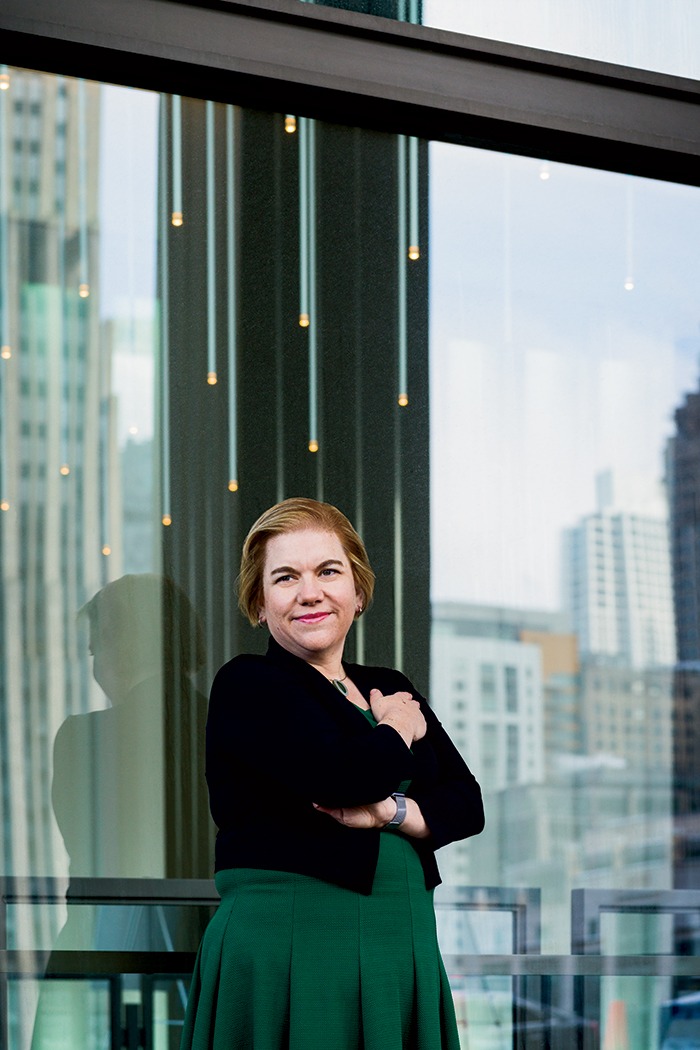
Comments are closed.